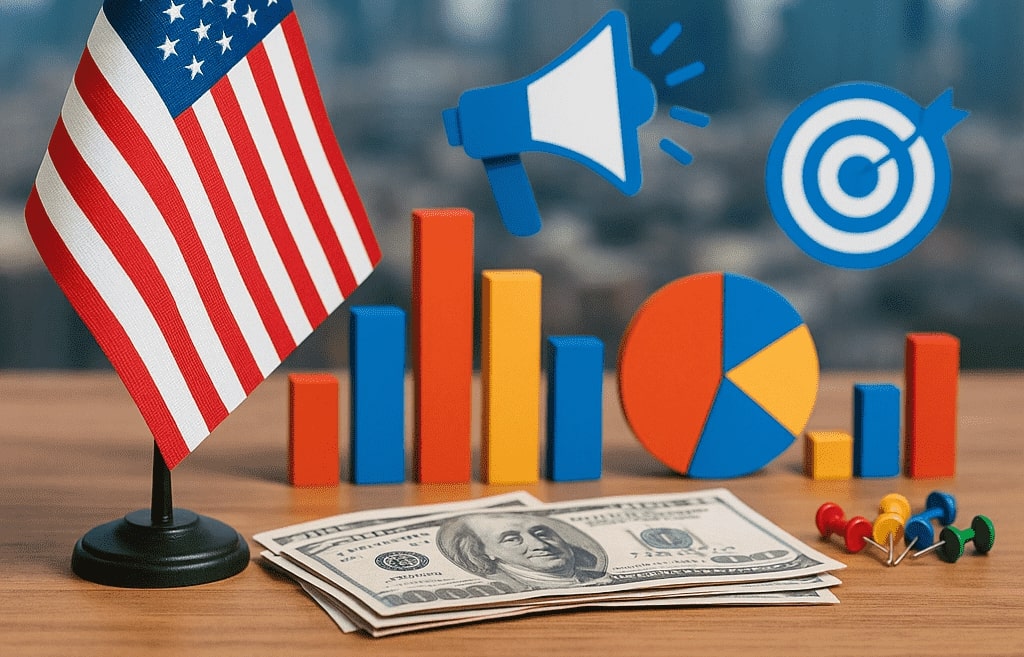When you think about what fuels modern business in the United States, it’s not just the products or the services; it’s the way they’re marketed. It’s the headlines that grab your attention mid-scroll, the Super Bowl commercials that spark Monday conversations, the TikTok trends that sell out a skincare brand overnight.
And behind all that? A colossal, complex, and constantly evolving industry, the American advertising and marketing sector.
But just how big is it? Let’s explore that.
A Snapshot of American (U.S.) Advertising and Marketing Industry Scale
Let’s start with a ballpark: The U.S. advertising and marketing industry is worth well over $500 billion annually. That’s not a typo. According to market intelligence reports and recent economic data:
- The U.S. ad market alone (digital + traditional) was estimated to hit $360–400 billion by 2024.
- Marketing services, including content marketing, branding, PR, market research, and digital consultancy, add hundreds of billions more.
- Digital advertising now accounts for more than 70% of total ad spend in the U.S. and is still climbing.
For context, this industry is larger than the GDP of entire countries. It rivals major sectors like healthcare, education, and construction—not just in terms of revenue but also in influence.
Advertising vs. Marketing – What’s the Difference?
Before we go deeper, let’s clarify something. While people often use advertising and marketing interchangeably, they’re not quite the same thing.
- Advertising is a subset of marketing. It’s the paid promotion of products or services, whether through TV spots, online banners, podcasts, or influencer shoutouts.
- Marketing is the umbrella—it includes strategy, branding, pricing, product research, public relations, content, and yes, advertising.
So when we talk about the size of the industry, we’re really looking at an ecosystem that’s much broader than just ad spend. It includes everything from the creative agency pitching brand ideas in Manhattan to the solo content creator building a niche audience on LinkedIn.
Digital Transformation in America: The Game-Changer
Not long ago, American ad budgets leaned heavily toward traditional media, ATL marketing, TV, radio, billboards, and print. But the last decade flipped the script.
Here’s how things are playing out now:
- Digital advertising spend in the U.S. alone exceeded $250 billion in 2023, led by giants like Google, Meta (Facebook, Instagram), and Amazon.
- Search marketing and social media advertising dominate, but video, programmatic ads, and retail media networks are rising fast.
- Content marketing, SEO, and influencer partnerships now claim significant slices of marketing budgets not as a novelty, but as a core strategy.
Why? Because digital is measurable, scalable, and personalized. American companies no longer guess what works; they test, analyze, and iterate in real time.
The Role of Marketing Agencies (And Their Massive Piece of the Pie)
It’s easy to focus on platforms and tech, but agencies remain a major driver of this industry’s size.
In the U.S., thousands of advertising and marketing firms, ranging from boutique creative shops to massive holding companies like WPP, Omnicom, and Publicis, serve as the operational muscle behind many campaigns.
These agencies employ:
- Creative professionals – writers, designers, video producers
- Data analysts and media planners
- Digital marketers and SEO experts
- Client strategists and brand consultants
All of these roles contribute to the employment footprint, with the advertising sector alone supporting over 300,000 jobs directly and millions more indirectly, through media, tech, and freelance ecosystems.
American Brands as Global Trendsetters
Here’s something worth pausing on: America isn’t just big in ad dollars, it’s a global tastemaker.
Think of campaigns like:
- Nike’s “Just Do It” evolution
- Apple’s minimalist product spots
- Old Spice’s surreal humor
- Coca-Cola’s feel-good nostalgia
These weren’t just ads, they were cultural moments. And American companies export this influence worldwide, not just selling products, but shaping the style and tone of marketing internationally.
So yes, the size of the American ad and marketing industry is measurable in money, but also in soft power.
Advertising and Marketing Industry Demand: Who’s Spending the Most?
Some industries simply need to advertise more aggressively than others. In the U.S., the top spenders include:
- Retail and eCommerce – Amazon, Walmart, Target, and DTC brands spend heavily to compete for eyeballs and conversions.
- Automotive – Traditional carmakers and EV brands alike invest big in TV, online video, and event-based marketing.
- Technology – Apple, Google, and Microsoft lead with product launches, lifestyle messaging, and content ecosystems.
- Financial Services – Credit cards, fintechs, insurance firms, they’re all racing for trust and attention.
- Healthcare and Pharma – Especially post-2020, this sector’s media spend ballooned, with patient education and product awareness at the forefront.
Each of these verticals drives billions of dollars in ad and digital marketing spend annually, shaping how the overall industry grows.
The Influence of Data and Analytics
Marketing used to be more art than science. Today, it’s both. And in America, where consumer data is king, the industry thrives on insights.
- Performance marketing tracks every click, conversion, and ROI metric.
- Predictive analytics help brands forecast trends and customer behavior.
- AI and machine learning are being used to personalize messaging at scale.
This obsession with data has created entire marketing sub-industries, MarTech platforms, analytics consultancies, and CRM software, which in turn inflate the size of the overall marketing ecosystem.
Employment and Economic Impact
As of recent estimates:
- The broader marketing and advertising services industry employs over 1.4 million people in the U.S. when you factor in media companies, freelancers, tech support, content producers, and consultants.
- Indirectly, it fuels jobs in printing, logistics, production, events, journalism, and tech development.
But beyond headcount, it also plays a vital role in economic movement. Every dollar spent on marketing doesn’t sit still; it circulates across vendors, talent, platforms, and audiences.
The Industry’s Supporting Pillars
You can’t talk about how big this industry is without acknowledging the ecosystem behind it:
- Media companies (like NBC, CNN, Spotify, The New York Times) earn billions annually through ad sales.
- Tech companies (like Google, Meta, Amazon, TikTok) essentially run on ads.
- Startups and SMBs often allocate 10–30% of their budgets to marketing, fueling demand for tools and expertise.
Even government agencies and nonprofits participate. From public health campaigns to tourism boards, marketing isn’t just for profit, it’s for reach.
Not Just Big—But Constantly Expanding
If it feels like marketing never stops growing, you’re not wrong.
Several factors contribute:
- Fragmentation of media means more platforms = more opportunities = more spend.
- Audience behavior is evolving, forcing brands to be always-on and ever-present.
- Innovation in AI, AR, and personalization pushes new frontiers in marketing tech.
There’s always a new trend to chase: live commerce, voice search, short-form content, virtual influencers. And American marketers are usually among the first to jump in and scale it.
Challenges and Shifts in Marketing & Advertising in the United States
It’s not all explosive growth. The industry also faces:
- Data privacy concerns (thanks to regulations like GDPR, CCPA)
- Ad fatigue and audience skepticism
- Cookie deprecation, shaking up how targeting works
- Rising ad costs and shrinking organic reach
So while the numbers are big, so is the pressure to evolve. And U.S. marketers are investing not just in ads but in ethics, transparency, and long-term brand trust.
So… How Big Is It Really?
Let’s round it out:
- $500+ billion industry in annual value
- Over 1.4 million people employed
- Influence that spans every American household and beyond
- Growing with tech, shifting with culture, adapting with data
It’s not just one of the largest industries in the U.S., it’s one of the most visible, agile, and indispensable.
And if history is any guide, it’s only going to get bigger.
Conclusion
You can’t walk down a street, scroll through your phone, or even open your fridge without being touched by the American advertising and marketing machine. It’s not background noise, it’s cultural infrastructure.
The U.S. doesn’t just lead in ad spend. It leads in experimentation, creativity, and reach. Whether you’re a business owner, marketer, or just a curious observer, you’re part of the system. And its size? Well, it’s massive. But more than that, it’s dynamic.
So the next time you see an ad that makes you laugh, think, or hit “buy now,” remember: you’re not just witnessing a campaign. You’re witnessing an industry in motion.

The Chief Editor cum author at Intothecommerce, bringing a unique blend of traditional and digital marketing expertise to the team. I oversee all editorial operations, utilizing my comprehensive knowledge to bridge classic marketing principles with modern digital strategies. My focus ensures our content is both timely and fundamentally sound.






1 thought on “How Large is the American Advertising and Marketing Industry?”
This is a topic that undoubtedly deserves far more attention, and I’m so pleased you addressed it with such meticulous care and comprehensive detail. Your willingness to explore the complexities of the American marketing industry makes this content indispensable.